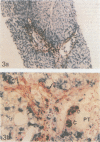Abstract
CA 19.9 antigen is mainly secreted by biliary and pancreatic duct cells. Its metabolism could be modified in genetic haemochromatosis by iron accumulation within these cells. Therefore, CA 19.9 was assayed in the serum samples of 84 patients with genetic haemochromatosis before and after iron depletion and immunolocalised in the liver of 24 untreated genetic haemochromatosis cases. The study showed that serum CA 19.9 (N < 37 IU/l) was increased (SD) before treatment (41.2 (34)) when compared with after the venesection period (16 (12)), and correlated, before treatment, with the amount of iron excess, transaminases, fibrosis, and biliary iron deposits. Hepatic CA 19.9 was located within the cytoplasm of bile duct and cholangiolar cells. In conclusion, this study shows that a mild, reversible, and non-specific increase in serum CA 19.9 is common in genetic haemochromatosis patients and shows that this increase is related to iron excess, directly or through associated liver damage. The unexplained finding of a mild increase in serum CA 19.9 should lead, in a patient with no diagnosis, to the search for liver iron overload, and, in a patient with untreated genetic haemochromatosis, not to further diagnostic procedures unless this finding persists after completion of the venesection treatment.
Full text
PDF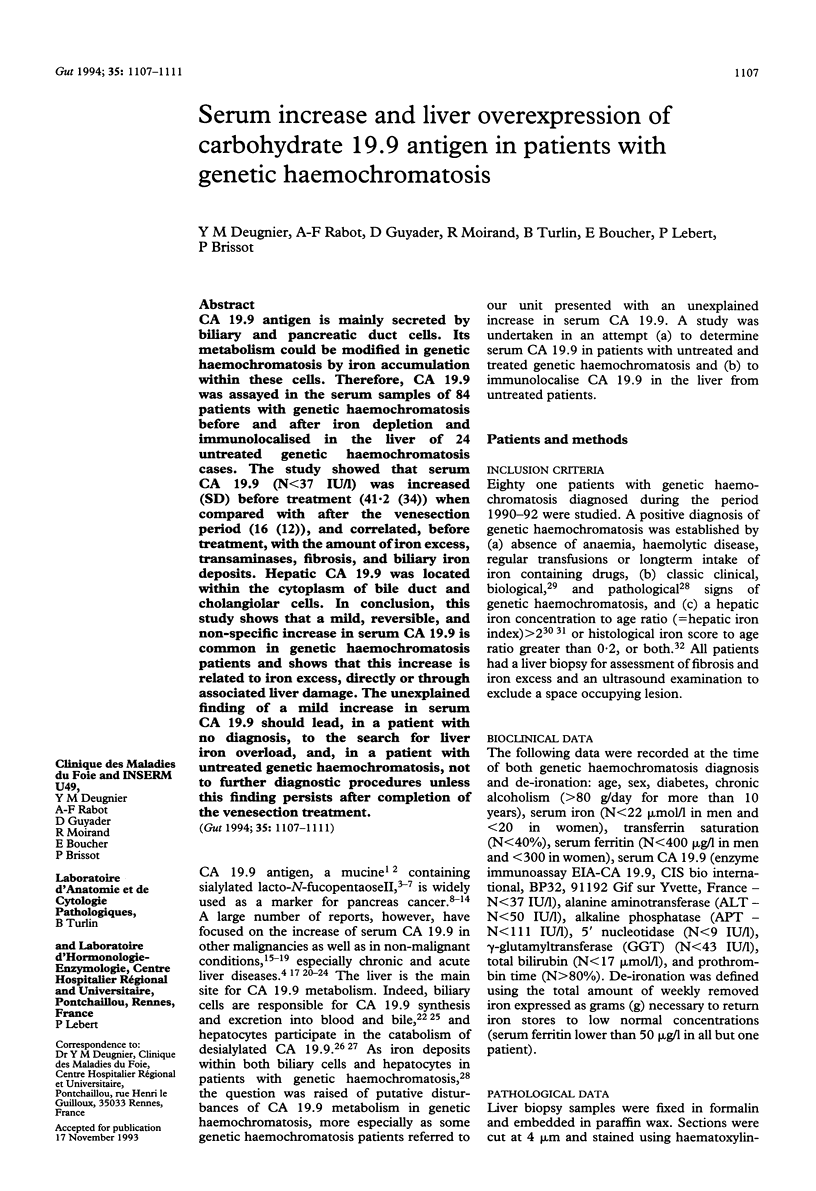
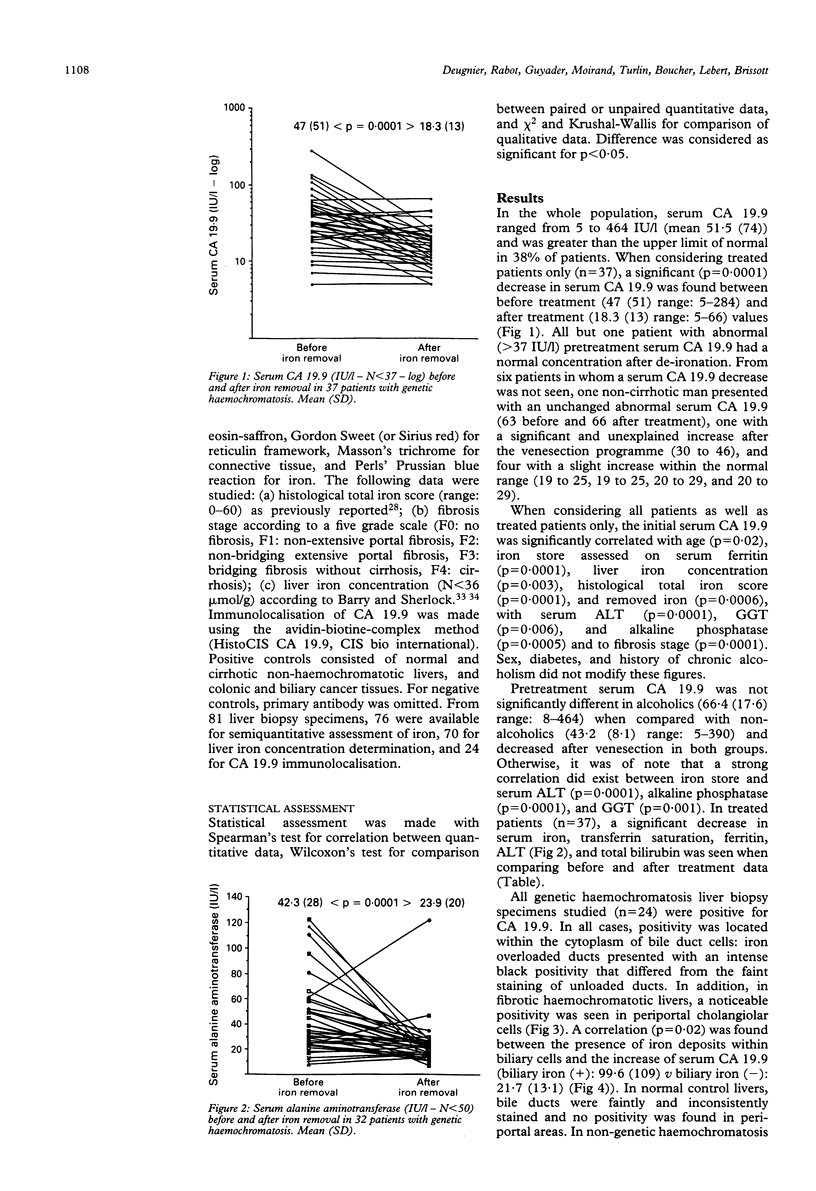
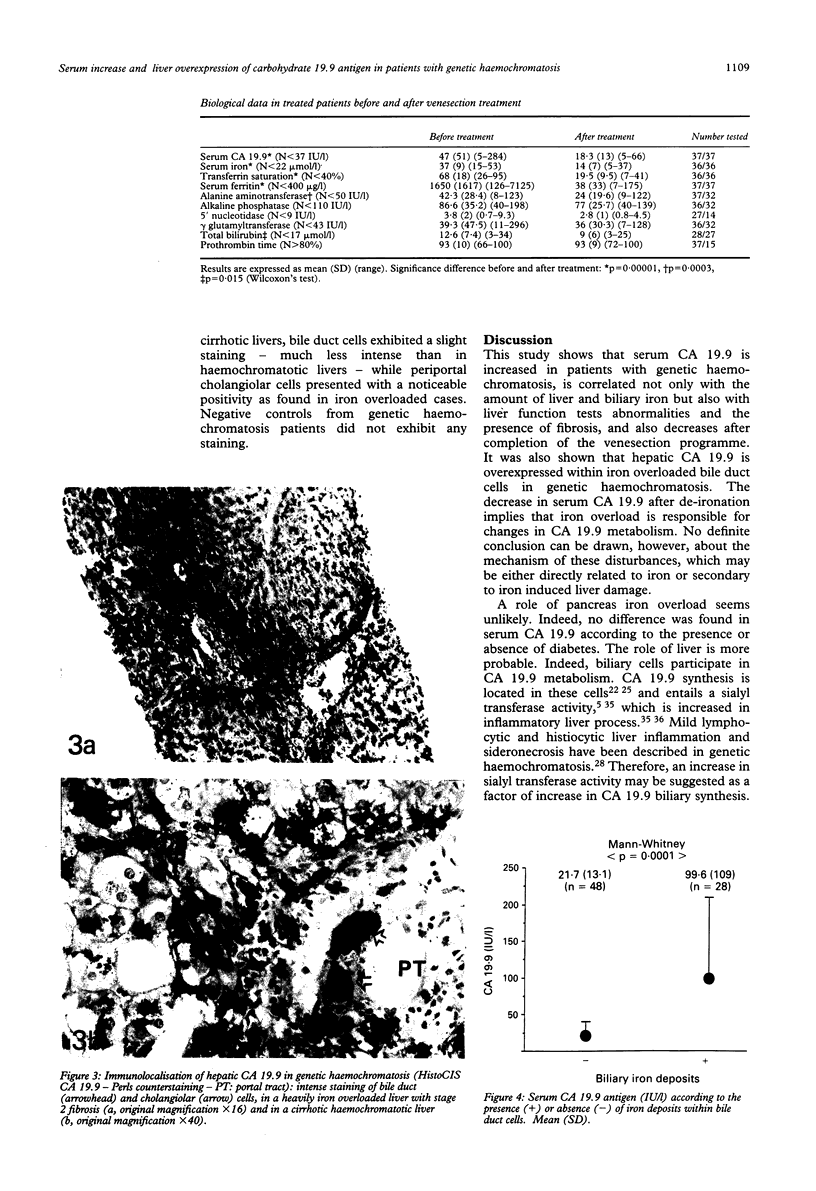
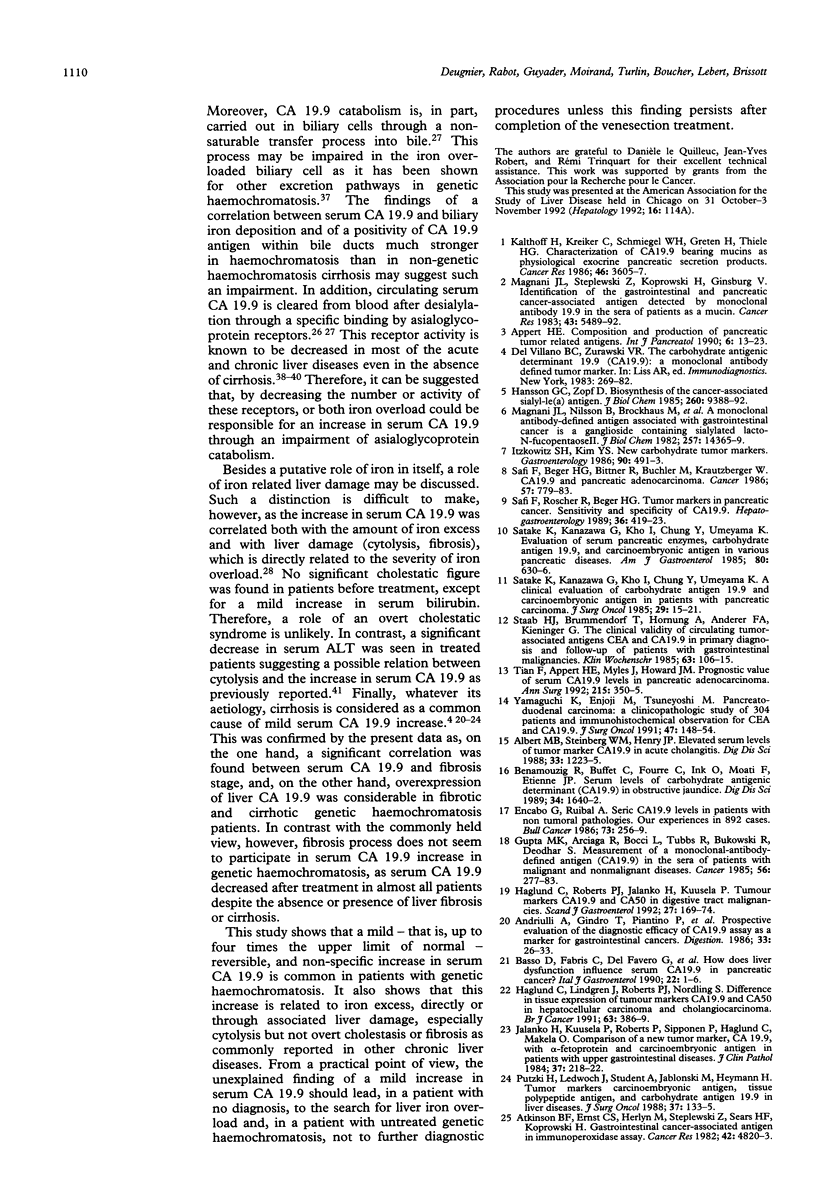
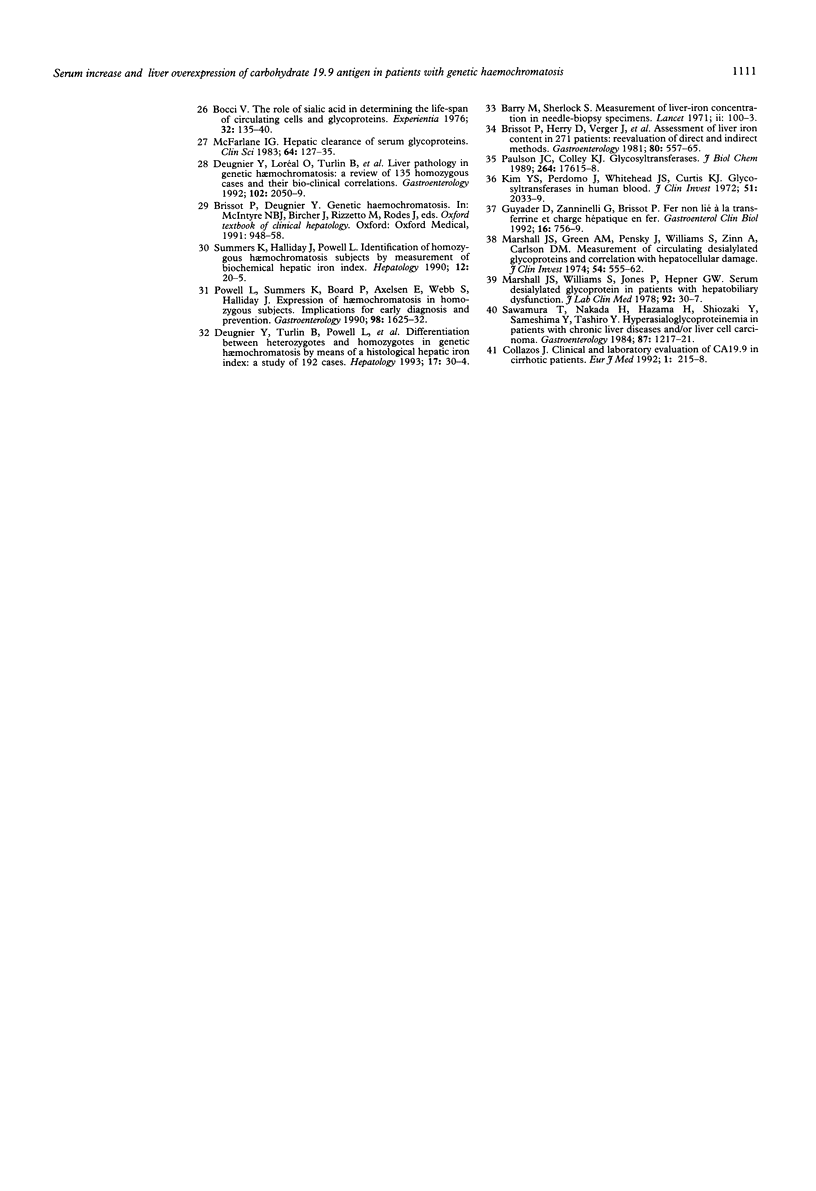
Images in this article
Selected References
These references are in PubMed. This may not be the complete list of references from this article.
- Albert M. B., Steinberg W. M., Henry J. P. Elevated serum levels of tumor marker CA19-9 in acute cholangitis. Dig Dis Sci. 1988 Oct;33(10):1223–1225. doi: 10.1007/BF01536670. [DOI] [PubMed] [Google Scholar]
- Andriulli A., Gindro T., Piantino P., Farini R., Cavallini G., Piazzi L., Naccarato R., Dobrilla G., Verme G., Scuro L. A. Prospective evaluation of the diagnostic efficacy of CA 19-9 assay as a marker for gastrointestinal cancers. Digestion. 1986;33(1):26–33. doi: 10.1159/000199271. [DOI] [PubMed] [Google Scholar]
- Appert H. E. Composition and production of pancreatic tumor related antigens. Int J Pancreatol. 1990 Aug-Nov;7(1-3):13–24. doi: 10.1007/BF02924216. [DOI] [PubMed] [Google Scholar]
- Atkinson B. F., Ernst C. S., Herlyn M., Steplewski Z., Sears H. F., Koprowski H. Gastrointestinal cancer-associated antigen in immunoperoxidase assay. Cancer Res. 1982 Nov;42(11):4820–4823. [PubMed] [Google Scholar]
- Barry M., Sherlock S. Measurement of liver-iron concentration in needle-biopsy specimens. Lancet. 1971 Jan 16;1(7690):100–103. doi: 10.1016/s0140-6736(71)90838-5. [DOI] [PubMed] [Google Scholar]
- Benamouzig R., Buffet C., Fourre C., Ink O., Moati F., Etienne J. P. Serum levels of carbohydrate antigenic determinant (CA 19.9) in obstructive jaundice. Dig Dis Sci. 1989 Oct;34(10):1640–1642. doi: 10.1007/BF01537129. [DOI] [PubMed] [Google Scholar]
- Bocci V. The role of sialic acid in determining the life-span of circulating cells and glycoproteins. Experientia. 1976 Feb 15;32(2):135–140. doi: 10.1007/BF01937727. [DOI] [PubMed] [Google Scholar]
- Brissot P., Bourel M., Herry D., Verger J. P., Messner M., Beaumont C., Regnouard F., Ferrand B., Simon M. Assessment of liver iron content in 271 patients: a reevaluation of direct and indirect methods. Gastroenterology. 1981 Mar;80(3):557–565. [PubMed] [Google Scholar]
- Collazos J. Clinical and laboratory evaluation of CA 19-9 in cirrhotic patients. Eur J Med. 1992 Jul-Aug;1(4):215–218. [PubMed] [Google Scholar]
- Deugnier Y. M., Loréal O., Turlin B., Guyader D., Jouanolle H., Moirand R., Jacquelinet C., Brissot P. Liver pathology in genetic hemochromatosis: a review of 135 homozygous cases and their bioclinical correlations. Gastroenterology. 1992 Jun;102(6):2050–2059. doi: 10.1016/0016-5085(92)90331-r. [DOI] [PubMed] [Google Scholar]
- Deugnier Y. M., Turlin B., Powell L. W., Summers K. M., Moirand R., Fletcher L., Loréal O., Brissot P., Halliday J. W. Differentiation between heterozygotes and homozygotes in genetic hemochromatosis by means of a histological hepatic iron index: a study of 192 cases. Hepatology. 1993 Jan;17(1):30–34. [PubMed] [Google Scholar]
- Encabo G., Ruibal A. Seric CA 19.9 levels in patients with non tumoral pathologies. Our experience in 892 cases. Bull Cancer. 1986;73(3):256–259. [PubMed] [Google Scholar]
- Gupta M. K., Arciaga R., Bocci L., Tubbs R., Bukowski R., Deodhar S. D. Measurement of a monoclonal-antibody-defined antigen (CA19-9) in the sera of patients with malignant and nonmalignant diseases. Comparison with carcinoembryonic antigen. Cancer. 1985 Jul 15;56(2):277–283. doi: 10.1002/1097-0142(19850715)56:2<277::aid-cncr2820560213>3.0.co;2-m. [DOI] [PubMed] [Google Scholar]
- Guyader D., Zanninelli G., Brissot P. Fer non lié à la transferrine et charge hépatique en fer. Gastroenterol Clin Biol. 1992;16(10):756–759. [PubMed] [Google Scholar]
- Haglund C., Lindgren J., Roberts P. J., Nordling S. Difference in tissue expression of tumour markers CA 19-9 and CA 50 in hepatocellular carcinoma and cholangiocarcinoma. Br J Cancer. 1991 Mar;63(3):386–389. doi: 10.1038/bjc.1991.90. [DOI] [PMC free article] [PubMed] [Google Scholar]
- Haglund C., Roberts P. J., Jalanko H., Kuusela P. Tumour markers CA 19-9 and CA 50 in digestive tract malignancies. Scand J Gastroenterol. 1992;27(3):169–174. doi: 10.3109/00365529208999944. [DOI] [PubMed] [Google Scholar]
- Hansson G. C., Zopf D. Biosynthesis of the cancer-associated sialyl-Lea antigen. J Biol Chem. 1985 Aug 5;260(16):9388–9392. [PubMed] [Google Scholar]
- Itzkowitz S. H., Kim Y. S. New carbohydrate tumor markers. Gastroenterology. 1986 Feb;90(2):491–494. doi: 10.1016/0016-5085(86)90954-6. [DOI] [PubMed] [Google Scholar]
- Jalanko H., Kuusela P., Roberts P., Sipponen P., Haglund C. A., Mäkelä O. Comparison of a new tumour marker, CA 19-9, with alpha-fetoprotein and carcinoembryonic antigen in patients with upper gastrointestinal diseases. J Clin Pathol. 1984 Feb;37(2):218–222. doi: 10.1136/jcp.37.2.218. [DOI] [PMC free article] [PubMed] [Google Scholar]
- Kalthoff H., Kreiker C., Schmiegel W. H., Greten H., Thiele H. G. Characterization of CA 19-9 bearing mucins as physiological exocrine pancreatic secretion products. Cancer Res. 1986 Jul;46(7):3605–3607. [PubMed] [Google Scholar]
- Kim Y. S., Perdomo J., Whitehead J. S., Curtis K. J. Glycosyltransferases in human blood. II. Study of serum galactosyltransferase and N-acetylgalactosaminyltransferase in patients with liver diseases. J Clin Invest. 1972 Aug;51(8):2033–2039. doi: 10.1172/JCI107009. [DOI] [PMC free article] [PubMed] [Google Scholar]
- Magnani J. L., Nilsson B., Brockhaus M., Zopf D., Steplewski Z., Koprowski H., Ginsburg V. A monoclonal antibody-defined antigen associated with gastrointestinal cancer is a ganglioside containing sialylated lacto-N-fucopentaose II. J Biol Chem. 1982 Dec 10;257(23):14365–14369. [PubMed] [Google Scholar]
- Magnani J. L., Steplewski Z., Koprowski H., Ginsburg V. Identification of the gastrointestinal and pancreatic cancer-associated antigen detected by monoclonal antibody 19-9 in the sera of patients as a mucin. Cancer Res. 1983 Nov;43(11):5489–5492. [PubMed] [Google Scholar]
- Marshall J. S., Green A. M., Pensky J., Williams S., Zinn A., Carlson D. M. Measurement of circulating desialylated glycoproteins and correlation with hepatocellular damage. J Clin Invest. 1974 Sep;54(3):555–562. doi: 10.1172/JCI107792. [DOI] [PMC free article] [PubMed] [Google Scholar]
- Marshall J. S., Williams S., Jones P., Hepner G. W. Serum desialylated glycoproteins in patients with hepatobiliary dysfunction. J Lab Clin Med. 1978 Jul;92(1):30–37. [PubMed] [Google Scholar]
- McFarlane I. G. Hepatic clearance of serum glycoproteins. Clin Sci (Lond) 1983 Feb;64(2):127–135. doi: 10.1042/cs0640127. [DOI] [PubMed] [Google Scholar]
- Paulson J. C., Colley K. J. Glycosyltransferases. Structure, localization, and control of cell type-specific glycosylation. J Biol Chem. 1989 Oct 25;264(30):17615–17618. [PubMed] [Google Scholar]
- Powell L. W., Summers K. M., Board P. G., Axelsen E., Webb S., Halliday J. W. Expression of hemochromatosis in homozygous subjects. Implications for early diagnosis and prevention. Gastroenterology. 1990 Jun;98(6):1625–1632. doi: 10.1016/0016-5085(90)91100-k. [DOI] [PubMed] [Google Scholar]
- Putzki H., Ledwoch J., Student A., Jablonski M., Heymann H. Tumor markers carcinoembryonic antigen, tissue polypeptide antigen, and carbohydrate antigen 19/9 in liver diseases. J Surg Oncol. 1988 Feb;37(2):133–135. doi: 10.1002/jso.2930370214. [DOI] [PubMed] [Google Scholar]
- Safi F., Beger H. G., Bittner R., Büchler M., Krautzberger W. CA 19-9 and pancreatic adenocarcinoma. Cancer. 1986 Feb 15;57(4):779–783. doi: 10.1002/1097-0142(19860215)57:4<779::aid-cncr2820570417>3.0.co;2-c. [DOI] [PubMed] [Google Scholar]
- Safi F., Roscher R., Beger H. G. Tumor markers in pancreatic cancer. Sensitivity and specificity of CA 19-9. Hepatogastroenterology. 1989 Dec;36(6):419–423. [PubMed] [Google Scholar]
- Satake K., Kanazawa G., Kho I., Chung Y. S., Umeyama K. A clinical evaluation of carbohydrate antigen 19-9 and carcinoembryonic antigen in patients with pancreatic carcinoma. J Surg Oncol. 1985 May;29(1):15–21. doi: 10.1002/jso.2930290106. [DOI] [PubMed] [Google Scholar]
- Satake K., Kanazawa G., Kho I., Chung Y., Umeyama K. Evaluation of serum pancreatic enzymes, carbohydrate antigen 19-9, and carcinoembryonic antigen in various pancreatic diseases. Am J Gastroenterol. 1985 Aug;80(8):630–636. [PubMed] [Google Scholar]
- Sawamura T., Nakada H., Hazama H., Shiozaki Y., Sameshima Y., Tashiro Y. Hyperasialoglycoproteinemia in patients with chronic liver diseases and/or liver cell carcinoma. Asialoglycoprotein receptor in cirrhosis and liver cell carcinoma. Gastroenterology. 1984 Dec;87(6):1217–1221. [PubMed] [Google Scholar]
- Staab H. J., Brümmendorf T., Hornung A., Anderer F. A., Kieninger G. The clinical validity of circulating tumor-associated antigens CEA and CA 19-9 in primary diagnosis and follow-up of patients with gastrointestinal malignancies. Klin Wochenschr. 1985 Feb 4;63(3):106–115. doi: 10.1007/BF01734248. [DOI] [PubMed] [Google Scholar]
- Summers K. M., Halliday J. W., Powell L. W. Identification of homozygous hemochromatosis subjects by measurement of hepatic iron index. Hepatology. 1990 Jul;12(1):20–25. doi: 10.1002/hep.1840120105. [DOI] [PubMed] [Google Scholar]
- Tian F., Appert H. E., Myles J., Howard J. M. Prognostic value of serum CA 19-9 levels in pancreatic adenocarcinoma. Ann Surg. 1992 Apr;215(4):350–355. doi: 10.1097/00000658-199204000-00008. [DOI] [PMC free article] [PubMed] [Google Scholar]



